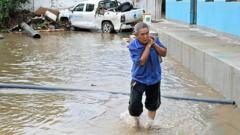Venomous snakes cause approximately five million bites annually, claiming 120,000 lives and leading to significant health complications, particularly affecting rural populations in Africa, where access to medical care is critically limited.
The Silent Crisis: Snakebites in Africa's Rural Communities

The Silent Crisis: Snakebites in Africa's Rural Communities
Millions suffer from venomous snakebites yearly, highlighting urgent healthcare disparities in Africa's underserved areas.
In the heart of rural Kenya, the everyday existence of locals is frequently disrupted by a lurking threat: venomous snakes. While these snakes are a natural part of the ecosystem, their increasing encounters with humans are leading to tragic outcomes. Across a range of African countries, including Kenya, India, and Brazil, a delicate balance between human habitation and snake habitats has been disturbed, resulting in a drastic spike in snakebite incidents.
Eleven-year-old Beatrice Ndanu Munyoki became one such victim one fateful afternoon in November 2023. While tending to her family’s goats, she was bitten on her right index finger by a snake that struck without warning. In a moment that no child should have to endure, Beatrice's life took a serious turn. Her father, David Mutunga, quickly fashioned a makeshift bandage and rushed her on a motorcycle to the nearest healthcare facility. Unfortunately, the small hospital in Mwingi was ill-equipped to provide the necessary treatment. After a race against time, which included a transfer to a different hospital, Beatrice was finally given antivenom. However, the damage had been done. Her injury escalated, resulting in the painful decision to amputate her finger.
This alarming scenario is not isolated. According to health statistics, around five million people are bitten by snakes every year, with 120,000 fatalities reported. These incidents are particularly concentrated among impoverished individuals in rural areas who often lack access to timely and effective treatment. This lack of resources in healthcare is compounded by environmental changes, including deforestation and urban sprawl, and the global consequences of climate change.
The stark reality that many are forced to live with reveals two intertwined crises: the immediate danger posed by snakes and the insufficient medical infrastructure in rural Africa. Urgent efforts are needed not only to improve healthcare access but also to educate communities on preventive measures against snake encounters. Addressing these issues could save countless lives and help vulnerable populations protect themselves from the dangers that slither too close to home.




















